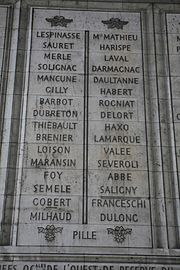Paul Thiébault
Paul Thiébault | |
|---|---|
General of Division | |
| Battles/wars | |
| Other work | Baron of the Empire , 1811 |

Paul Charles François Adrien Henri Dieudonné Thiébault (French pronunciation:
Life
His father was
He served at the Battle of Rivoli, distinguished himself in the assault on Naples in January 1799 and then retired the following June. Recalled in January 1800, he was attached to the armée d’Italie, where he served on Masséna's staff at the siege of Genoa.[1] He was made a general in 1801 and commanded the 2nd brigade of the 1st infantry division at Austerlitz, in support of Vandamme, making him part of the army corps which mounted the assault and took the Pratzen plateau. He was wounded during the battle.
He was then made governor of
Family
His father is Dieudonné Thiébault.
Thiébault married Betsy Walker the daughter of the novelist Lady Mary Hamilton.[2] His son Adolphe (1797-1875) became a military tutor and antiquities collector. Adolphe gathered together the family's papers and these are available at Yale University.[2]
Works
- Journal des opérations militaires du siège et du blocus de Gênes, written in 1801
- Relation de l’expédition du Portugal faite en 1807 et 1808
- Manuel général du service des états-majors généraux et divisionnaires dans les armées
- Mémoires
- Memoirs of Baron Thiébault (transl. by A. J. Butler), London, 1896
- Du chant, et particulièrement de la romance, 1813
References
- ^ La caduta di Luigia Pallavicini nelle memorie di Thiebault
- ^ a b Ducharme, Diane J. (2010). "Guide to the Lady Mary Hamilton Papers". Yale University Library. Yale University.
